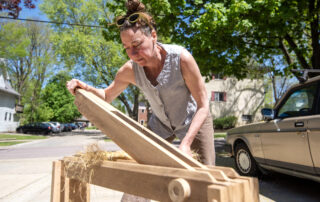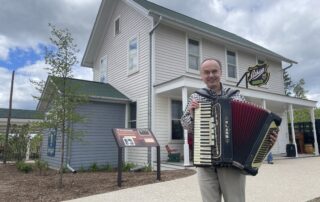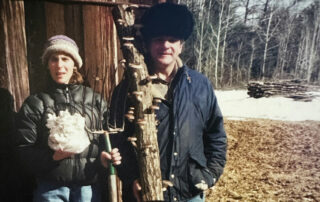Sawing, nailing, laughing are the sounds you hear in Eric Adjetey Anang’s carpentry shop. Listen closer and you will hear his family’s legacy. Anang is a third generation craftsman in the art of design coffins. People will often ask him, “What are you building?” and when he answers a coffin, they’re like “Oh!”
Anang’s coffins are one of Ghana’s most unique cultural exports. It’s a business his grandfather started. The idea came about when Anang’s grandmother died. She had watched with great curiosity when the Ghana’s Kotoka International Airport was built in 1951. She mentioned how she would love to fly in one of those planes, but she never got the opportunity before she passed away. So, when she died Anang’s grandfather built her a coffin in the form of a plane to fly her into the afterlife.
As a little boy, Anang remembers the curiosity he had about the family business and also the fear he had about coffins in the backyard. A funeral in Ghana can attract 500 to 2,000 because everyone wants to have a glance of the coffin and take a photo of the coffin. And that’s where the murmur in the crowd begins. “Who did that? Who was the artist? Where was that coffin built?” In the end, that is where the coffin artist will find their praise. The coffins can sell from $500 to $1,000.
Despite his father’s reservation about Anang joining the family business, he honored his birthright and took up the tools of the trade. The coffins are steeped in a rich tradition and each has its own story. Like the corn cob coffin designed in Iowa to commemorate that state’s ties to corn growing. There’s a bumblebee coffin designed to provoke thought about the disappearance of bees. Traditionally, design coffins can also symbolize a hobby, a favorite item or a person’s importance to their community. The Chazen Museum of Art in Madison is home to Anang’s eagle coffin. It’s a design reserved for people of prominence.
In 2018, Anang took on a project at the Madison Public Library in a space where the smell of fresh-cut pine filled the air and where library patrons could learn, share and create. This time, his hammer and saw are pounding out a dinosaur to bring awareness to the plight of other animals that are endangered or extinct. Anang has already thought about his own coffin and he selected a wooden plain. A common tool in this trade. The wooden plain is always beside him in his workshop and it’s one he’s been using for a long time.
Anang’s work is one of the most celebrated forms of African art and he is fiercely proud of his grandfather’s legacy. Anang said, “This is really a dream to be here, to share with people the story of my family and what we do. I mean, that’s what has made me who I am today.”
Eric Adjetey Anang Describes His Move to Madison
Related Links for this Article
The Master of Coffins (documentary about Eric Adjetey Anang's design coffins) on YouTube form 2012








